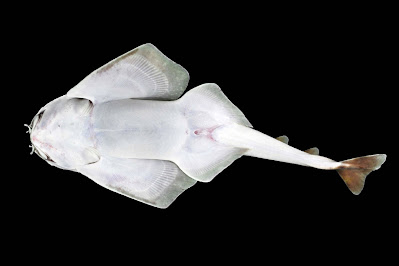 |
| Squatina mapama Long, Ebert, Tavera, Acero P. & Robertson, 2021 |
Integrating both morphological and genetic data, we describe Squatina mapama, a new species of the angel shark genus Squatina, found on the upper continental slope off the Caribbean coast of Panamá. Distinguishing characters of S. mapama include a wider pectoral and pelvic span; a shorter head length; a narrower mouth; short fringed nasal flaps and barbels; a few large denticles on top of the head; a single dorsal midline row of slightly enlarged denticles from the level of the posterior insertion of the pelvic fin to the first dorsal fin and continuing past the first dorsal fin to the second dorsal-fin origin; and the presence of smaller scattered spots in males, which, in combination, allow separation of this new species from the closely related and sympatric species Squatina david. The new species can be distinguished from all other currently recognized Squatina species by meristic and morphometric measures, as well as by sequence differences in the mtDNA COI marker. Phylogenetic analysis shows Squatina mapama n. sp. to be a basal member of a small clade of western Atlantic Squatina species that includes Squatina occulta, Squatina guggenheim, and S. david, which likely evolved in the late Oligocene or Miocene period. We also report a western range extension of S. david from Colombia to the western Caribbean coast of Panamá.
Key words: taxonomy, ichthyology, fishes, Atlantic Ocean, Panama, phylogenetics, clades, DNA barcodes
 |
| Squatina mapama, fresh holotype, USNM 400784, 400 mm TL male, Caribbean Panama (D.R. Robertson). |
 |
| Squatina mapama, fresh holotype, ventral view, USNM 400784, Caribbean Panama (D.R. Robertson). |
 |
| Squatina mapama, fresh holotype detail of nasal flaps, USNM 400784, Caribbean Panama (D.R. Robertson). |
Squatina mapama, n. sp.
Small-crested Angelshark; angelote de cresta pequeña
Diagnosis. A Squatina species with a combination of: a single row of slightly enlarged dermal denticles
along dorsal midline extending between level just anterior of posterior insertion of pelvic fins and anterior base
of first dorsal fin and continuing rearwards along dorsal ridge of tail between first and second dorsal fins; a few
large denticles on top of head; nasal flap squared with a fine fringe on ventral edge; two short lateral barbels
bluntly rounded also with a fine fringed margin; males with a dorsal color pattern of small, scattered, dark spots
distributed over a uniform light-brown background; pectoral-fin span 52.0–58.1% TL; pelvic-fin span 30.7–31.0
% TL; pre-pectoral-fin length 19.4–19.8% TL; trunk width 18.1–19.5% TL; head length 16.5–17.5% TL; spiracle
length 2.2–2.3% TL; eye-to-spiracle length 2.2–5.0 % TL; mouth width 10.5–12.1% TL; nostril width 1.6–2.3%
TL; snout-to-pectoral distance 19.4–19.8%; spiracle width 2.2–2.3% TL; pectoral-fin inner margins 17.5–18.3%.
Etymology. The specific epithet mapama refers to the acronym MAPAMA, the Ministerio de Agricultura y
Pesca, Alimentación y Medio Ambiente, which is the Spanish governmental organization that operates the R/V
Miguel Oliver. This name recognizes the support of MAPAMA for the research cruises to Central and South
America that facilitated the capture of this angelshark, and other new species of deepwater fishes on both sides
of the Central American isthmus (Vázquez et al. 2015, Concha et al. 2016, Robertson et al. 2017).
Suggested
common name of Small-crested Angelshark or angelote de cresta pequeña is in reference to the short and narrow
median line of small dermal denticles
Douglas J. Long, David A. Ebert, Jose Tavera, Arturo Acero P. and Ross Robertson. 2021. Squatina mapama n. sp., A New Cryptic Species of Angel Shark (Elasmobranchii: Squatinidae) from the southwestern Caribbean Sea Journal of the Ocean Science Foundation, 38, 113-130. DOI: 10.5281/zenodo.5806693